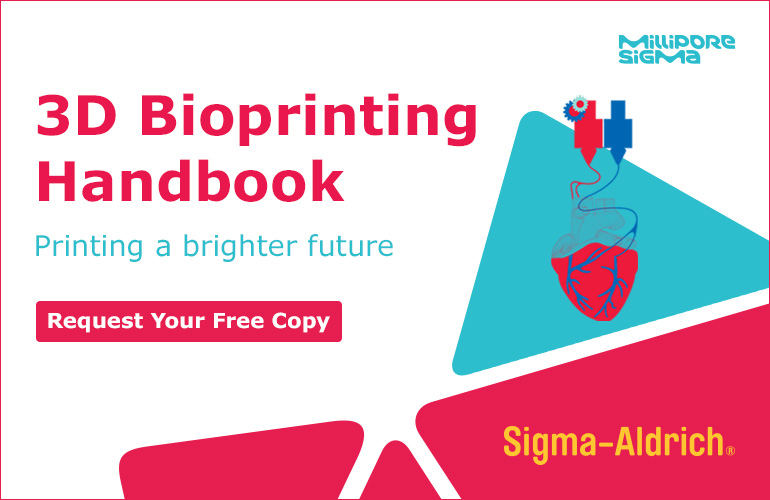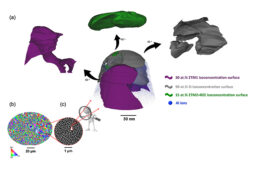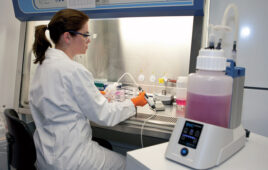By Elizabeth Aisenbrey, Ph.D., Global Product Manager
3D bioprinting is a powerful tool that enables researchers to create reproducible 3D constructs for high throughput screening and in vitro tissue models. The ease of use and ability to seamlessly print multi-materials make micro-extrusion-based bioprinting an attractive technique. Despite promising advancements in 3D bioprinting technology, a need for high quality, commercially available ready-to-use bioinks remains to enable groundbreaking research. For this, MilliporeSigma has developed the TissueFab® bioink platform, a complete suite of ready-to-use bioinks that are compatible with a diverse set of widely studied cell types and bioprinting platforms.
Learn more about 3D bioprinting in our 3D bioprinting handbookThe TissueFab® bioinks contain high quality, low endotoxin natural and synthetic polymers with high batch-to-batch consistency. Each printer-agnostic bioink is designed, tested, and verified for optimal printability and mechanical properties for micro-extrusion based bioprinting using the most popular commercial bioprinters. Step-by-step protocols developed and validated by MilliporeSigma’s 3D bioprinting scientists are included to eliminate the guesswork and accelerate research. The TissueFab® bioinks enable easy, rapid, and cell friendly crosslinking through a variety of methods, including thermally, ionically, or photochemically, with a wide range of compatible wavelengths. All TissueFab® bioinks have been validated for high cell viability, proliferation, and metabolic activity using widely used cell types in 3D bioprinting, including C2C12 mouse myoblast cells, human mesenchymal stem cells (hMSCs), and human adult dermal fibroblasts.
MilliporeSigma’s comprehensive portfolio of TissueFab® bioinks includes general purpose bioinks, facile curable bioinks, and tissue specific bioinks. The general purpose bioinks include formulations of gelatin, hyaluronic acid, alginate, and their derivatives, including methacrylates (i.e., GelMA) which show high cell viability, printability at physiological temperatures, and shape fidelity during cell culture. The large variety of general purpose bioinks available from MillporeSigma provides researchers with the opportunity to explore and select the bioink that best suits their target application or area of interest.
Another class of MilliporeSigma’s bioinks are the TissueFab® Facile Curable bioinks. Photocrosslinking is widely used in 3D bioprinting due to the simple nature of the functionalization chemistry and the temporal triggerability of the crosslinking post-print, ultimately avoiding clogging and handling issues. While photocrosslinking provides simplicity, it is known that UV light can damage cellular DNA and that photoinitiators can be cytotoxic. Moving away from photocrosslinking, the TissueFab®Facile Curable Bioinks are a class of ionically crosslinkable bioinks. These bioinks avoid using light and photoinitiators to form a stable construct while maintaining high cell viability.
MilliporeSigma also offers TissueFab® tissue-specific bioinks. TissueFab® Conductive Bioinks are electrically conductive bioinks intended to generate ideal cell environments for nerve, muscle, and cardiac cells by enabling the transfer of electrical signals and ultimately enhancing cell communication and the capacity for network formation. These conductive bioinks exhibit superior conductivity compared to GelMA and other commercially available bioinks, making them suitable for bioprinting electroactive tissue. TissueFab® Bone bioinks are designed to promote osteogenic differentiation of stem cells for bone tissue engineering applications. These bioinks contain hydroxyapatite, a bioceramic that mimics the mineralized phase of bone and accounts for the excellent biocompatibility, osteoinductive, and osteoconductive properties favorable for bone regeneration. The osteogenic potential of the TissueFab® Bone bioinks was assessed by osteocalcin expression of encapsulated hMSCs compared to control formulations. Results found that hMSCs encapsulated in the TissueFab® Bone bioinks expressed more osteocalcin over 28 days than the control formulation indicating the promotion of osteogenic differentiation.
3D bioprinting offers a method to reproducibly fabricate complex tissues and structures for regenerative medicine and drug discovery. MilliporeSigma TissueFab® bioinks provide a robust tissue-mimetic platform for microextrusion-based bioprinting of various cell types with high printability and cell viability. TissueFab® bioinks enable on-demand tissue printing, a tangible step forward for addressing drug testing and tissue engineering challenges.
To learn more about TissueFab® bioinks and find a full list of available productsSponsored content provided by Merck. The Life Science business of Merck operates as MilliporeSigma in the U.S. and Canada







Tell Us What You Think!